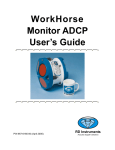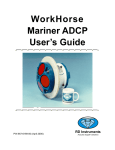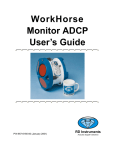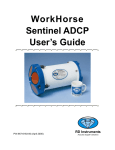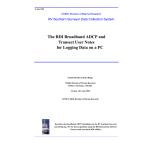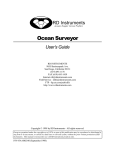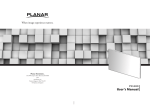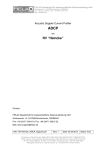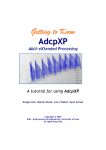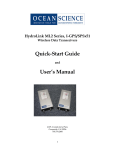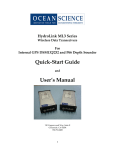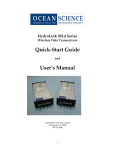Download WorkHorse Rio Grande ADCP User's Guide
Transcript
WorkHorse Rio Grande ADCP User’s Guide P/N 957-6167-00 (April 2005) RD Instruments Acoustic Doppler Solutions Table of Contents 1 Introduction....................................................................................................................................... 1 2 WorkHorse Rio Grande ADCP Applications .................................................................................. 2 3 System Overview .............................................................................................................................. 2 3.1 3.2 3.3 3.4 4 Rio Grande ADCP Overview...............................................................................................................3 I/O Cable Overview.............................................................................................................................5 Optional Flash Memory Card ..............................................................................................................6 Spare Parts .........................................................................................................................................7 WorkHorse Care................................................................................................................................ 8 4.1 4.2 4.3 5 General Handling Guidelines ..............................................................................................................8 Assembly Guidelines ..........................................................................................................................9 Deployment Guidelines .......................................................................................................................9 Setup the WorkHorse Rio Grande ADCP ..................................................................................... 10 5.1 5.2 6 Serial Communication .......................................................................................................................10 What if the WorkHorse Does Not Respond.......................................................................................10 Software........................................................................................................................................... 11 6.1 6.2 7 System Requirements.......................................................................................................................11 Software Installation..........................................................................................................................12 Power ............................................................................................................................................... 12 7.1 7.2 8 Bench-Top Battery Power Requirements..........................................................................................12 Operation Modes ..............................................................................................................................12 Testing Your WorkHorse................................................................................................................ 13 9 Compass Calibration...................................................................................................................... 14 9.1 9.2 9.3 10 Preparing for Calibration ...................................................................................................................14 Compass Calibration Verification ......................................................................................................15 Compass Calibration Procedure .......................................................................................................16 Internal Pressure Sensor ............................................................................................................... 18 10.1 11 Deployment Guide .......................................................................................................................... 19 11.1 11.2 11.3 11.4 11.5 12 Pressure Sensor Maintenance..........................................................................................................18 Deployment Checklist .......................................................................................................................19 Prepare the ADCP for Deployment ...................................................................................................20 Deployment Software........................................................................................................................20 Deploy the ADCP..............................................................................................................................21 Send the Deployment Commands ....................................................................................................22 Reviewing the Data......................................................................................................................... 22 12.1 12.2 12.3 'Where' was the Data? ......................................................................................................................22 'When' was the Data? .......................................................................................................................22 'What' is the Data? ............................................................................................................................22 13 A Few Principles of Operation ...................................................................................................... 23 14 Technical Support .......................................................................................................................... 24 List of Figures Figure 1. Figure 2. Figure 3. Figure 4. Figure 5. Figure 6. Figure 7. Figure 8. Figure 9. Figure 10. Rio Grande ADCP Overview ........................................................................................... 4 Connecting and Disconnecting the I/O Cable.................................................................. 5 I/O Cable Overview ......................................................................................................... 6 Memory Card Overview................................................................................................... 7 WorkHorse Rio Grande Connections ............................................................................ 10 BBTalk Command History Box ...................................................................................... 15 Compass Alignment ...................................................................................................... 17 Visual Inspection before Deployment ............................................................................ 19 Prepare the ADCP......................................................................................................... 20 Real-Time Deployment.................................................................................................. 21 List of Tables Table Table Table Table 1: 2: 3: 4: WorkHorse Rio Grande Application Guide ...................................................................... 2 Spare Parts ..................................................................................................................... 7 WorkHorse Software Main Modules .............................................................................. 11 WorkHorse ADCP Tests ................................................................................................ 13 WorkHorse Rio Grande ADCP User's Guide Acoustic Doppler Solutions WorkHorse Rio Grande ADCP User's Guide 1 Introduction Thank you for purchasing the RD Instruments (RDI) Rio Grande WorkHorse. This guide is designed to help first time WorkHorse users to set up, test, and deploy their ADCP. This guide is designed for use with the other WorkHorse Technical Manual guides. Where needed, there are references to detailed information and figures contained in the WorkHorse Technical Manual. WorkHorse Rio Grande deployments are most often Real-Time. Real-Time use refers to the fact you are viewing the data as the ADCP collects it via a personal computer. This data is also stored on the computer to allow for data playback and processing at a later time. NOTE. When you receive your WorkHorse, look for a set up card that shows all of the pieces you should have in your box. If anything is missing or damaged, contact RDI immediately. NOTE. When an addition or correction to the manual is needed, an Interim Change Notice (ICN) will be posted to our web site on the Customer Service page (www.rdinstrument.com). Please check our web site often. P/N 957-6167-00 (April 2005) page 1 WorkHorse Rio Grande ADCP User's Guide 2 WorkHorse Rio Grande ADCP Applications The Workhorse Rio Grande ADCP provides customers with reliable and repeatable river discharge measurements, and displays the results through its exceptional, user-friendly WinRiver software. For detailed information on how to use WinRiver, see the WinRiver User’s Guide. The WorkHorse Rio Grande ADCP can also be used in other moving vessel real time applications that take advantage of the Rio Grande’s bottom tracking abilities. WinRiver is the most often used software package for Rio Grande ADCP setup, real-time data collection, and data review. RDI also offers the VmDas program for ADCP setup, real-time data collection, and data review. For detailed information on how to use VmDas, see the VmDas User’s Guide. Table 1: WorkHorse Rio Grande Application Guide Estuaries/River Costal and Continental Shelf Rio Grande using WinRiver Rio Grande using VmDas • River, stream and channel discharge • Plume tracking • Suspended sediment load estimation • Environmental surveys • Plume tracking • Planning new ports • Bridge scouring • Current mapping • Simultaneous bathymetry discharge, flow structure • Costal engineering • Cable and pipe laying • Circulation/model studies 3 System Overview The WorkHorse Rio Grande is designed to measure real-time current profiles from temporary or permanent mounting in a vessel. The Rio Grande ADCP system consists of an ADCP with Bottom Track mode, High Resolution Water Profiling modes, cables, and software. The input power requirements for the Rio Grande are +12 VDC. The Rio Grande system requires the addition of a Windows® compatible computer to collect data. NOTE. Do not attempt to attach a Workhorse Monitor/Sentinel I/O cable or power supply to the Workhorse Rio Grande ADCP. The Workhorse Monitor and Sentinel ADCPs are 20 to 50 VDC systems. The Workhorse Rio Grande uses 12 VDC only. NOTE. The Rio Grande End-Cap is red to differentiate it from the Monitor and Sentinel ADCPs. Do not swap end-caps between a Rio Grande and a Monitor/Sentinel. The pin-outs are different on both the I/O cable connector and the internal I/O cable. page 2 RD Instruments WorkHorse Rio Grande ADCP User's Guide 3.1 Rio Grande ADCP Overview The transducer assembly contains the transducer ceramics and electronics. Standard acoustic frequencies are 600, and 1200kHz. See the outline drawings in the Installation Guide for dimensions and weights. I/O Cable Connector – Input/Output (I/O) cable connects the WorkHorse ADCP to the computer. Beam-3 Mark – The Beam-3 mark shows the location of Beam-3 (Forward). Urethane Face – The urethane face covers the transducer ceramics. Never set the transducer on a hard surface. The urethane face may be damaged. Housing – The standard WorkHorse housing allows deployment depths to 200 meters. Thermistor – The Thermistor measures the water temperature. Pressure Sensor – The Optional pressure sensor measures water pressure (depth). Transducer Head – The WorkHorse electronics and transducer ceramics are mounted to the transducer head. The numbers embossed on the edge of the transducer indicates the beam number. When assembling the unit, match the transducer beam number with the Beam 3 mark on the end-cap. End-Cap – The end-cap holds the I/O cable connector. When assembling the unit, match the Beam 3 mark on the end-cap with beam 3 number on the transducer. P/N 957-6167-00 (April 2005) page 3 WorkHorse Rio Grande ADCP User's Guide PRESSURE SENSOR (OPTIONAL) URETHANE FACE THERMISTOR BEAM 3 MARK TRANSDUCER HEAD HOUSING END-CAP I/O CABLE CONNECTOR Figure 1. page 4 Rio Grande ADCP Overview RD Instruments WorkHorse Rio Grande ADCP User's Guide 3.2 I/O Cable Overview Always remove the retaining strap on the end-cap underwater-connect cable and dummy plug when disconnecting them. Failure to do so will break the retainer strap. Do not apply any upward force on the end-cap connector as the I/O cable is being disconnected. Stressing the end-cap connector may cause the ADCP to flood. Read the Maintenance guide for details on disconnecting the I/O cable. Figure 2. Connecting and Disconnecting the I/O Cable NOTE. The Rio Grande End-Cap is red to differentiate it from the Monitor and Sentinel ADCPs. Do not swap end-caps between a Rio Grande and a Monitor/Sentinel. The pin-outs are different on both the I/O cable connector and the internal I/O cable. P/N 957-6167-00 (April 2005) page 5 WorkHorse Rio Grande ADCP User's Guide 4 8 3 2 7 6 1 5 P1 RS-232IN/CH A RS485A/RS-422 OUT A 1 RS-232OUT/CH A RS485B/RS-422 OUT B 2 CH B RS485B/RS-422 IN A 5 CH B RS485B/RS-422 IN B 6 BLU BRN COMMUNICATION RETURN 3 GRN 5 SPARE 7 RED 4 POWER (+) POWER (-) 4 8 ORG WHT RED YEL BLK BLK Figure 3. 3.3 P2 BLK 3 WHT 2 9 8 P3 (RED) P4 (BLACK) I/O Cable Overview Optional Flash Memory Card Memory cards are not included with the Rio Grande ADCP. Two PCMCIA memory card slots (see Figure 4, page 7) are available, with the total memory capacity not to exceed 2GB. The PC Card recorder is located on the Digital Signal Processor (DSP) board inside the Workhorse’s electronics. To recover data, the card can be removed and used in a personal computer (PC), or left in the Workhorse, and accessed by using WinSC (see the WinSC and Plan ADCP User's Guide). NOTE. The WorkHorse Rio Grande does not come with flash memory, but has the same capacity as a WorkHorse Sentinel. NOTE. WinSC is not provided with WorkHorse Rio Grande systems, but is available for free download at www.rdinstruments.com. page 6 RD Instruments WorkHorse Rio Grande ADCP User's Guide Figure 4. 3.4 Memory Card Overview Spare Parts The following parts are included in the spare parts kit. Table 2: Spare Parts Description Part number O-ring, face 2-260 Desiccant, sealed bag DES3 Lubricant, silicone, 5.3 oz, Dow-Corning DC-111 Fuse, 3.0 Amp, 250V GMA-3A P/N 957-6167-00 (April 2005) page 7 WorkHorse Rio Grande ADCP User's Guide 4 WorkHorse Care This section contains a list of items you should be aware of every time you handle, use, or deploy your WorkHorse. Please refer to this list often. 4.1 page 8 General Handling Guidelines • Never set the transducer on a hard or rough surface. The urethane faces may be damaged. • Always remove the retaining strap on the end-cap underwater-connect cable and dummy plug when disconnecting them. Failure to do so will break the retainer strap. • Do not apply any upward force on the end-cap connector as the I/O cable is being disconnected. Stressing the end-cap connector may cause the ADCP to flood. Read the Maintenance guide for details on disconnecting the I/O cable. • Do not expose the transducer faces to prolonged sunlight. The urethane faces may develop cracks. Cover the transducer faces on the Workhorse if it will be exposed to sunlight. • Do not expose the I/O connector to prolonged sunlight. The plastic may become brittle. Cover the connector on the Workhorse if it will be exposed to sunlight. • Do not store the ADCP in temperatures over 75 degrees C. The urethane faces may be damaged. Check the temperature indicator inside the shipping case. It changes color if the temperature limit is exceeded. • Do not scratch or damage the O-ring surfaces or grooves. If scratches or damage exists, they may provide a leakage path and cause the ADCP to flood. Do not risk a deployment with damaged O-ring surfaces. • Do not lift or support a WorkHorse by the external I/O cable. The connector or cable will break. RD Instruments WorkHorse Rio Grande ADCP User's Guide 4.2 4.3 Assembly Guidelines • Read the Maintenance guide for details on WorkHorse reassembly. Make sure the housing assembly O-rings stay in their groove when you re-assemble the WorkHorse. Tighten the hardware as specified. Loose, missing, stripped hardware, or damaged O-rings can cause the WorkHorse transducer to flood. • Place a light amount of DC-111 lubricant on the end-cap connector pins (rubber portion only). This will make it easier to connect or remove the I/O cable and dummy plug. • Do not connect or disconnect the I/O cable with power applied. The connector pins may become pitted and worn. • The WorkHorse I/O cable is wet mate-able, not under water mate-able. Deployment Guidelines • Read the appropriate WorkHorse User’s Guide and the Software User’s Guides. These guides have tutorials to help you learn how to use the ADCP. • Align the compass whenever the battery pack or recorder module is replaced, or when any ferrous metals are relocated inside or around the WorkHorse housing. Ferro-magnetic materials affect the compass. • Avoid using ferro-magnetic materials in the mounting fixtures or near the Workhorse. Ferro-magnetic materials affect the compass. P/N 957-6167-00 (April 2005) page 9 WorkHorse Rio Grande ADCP User's Guide 5 Setup the WorkHorse Rio Grande ADCP Figure 5 illustrates how to connect the WorkHorse Rio Grande cable on your workbench. You will need a container of water large enough to submerge the WorkHorse’s transducer head into during testing (two to three inches of water is sufficient). Testing the WorkHorse out of water may cause some tests to fail but causes no harm to the WorkHorse. BBTalk COMPUTER ADCP I/O CABLE 12 VDC BATTERY Figure 5. 5.1 WorkHorse Rio Grande Connections Serial Communication The standard communications settings for a WorkHorse Rio Grande is RS232, 9600-baud, no parity, 8 data bits and 1 stop bit. If the serial protocol is set for RS232 and your computer expects RS422, you will need an RS232 to RS422 adapter between the WorkHorse cable and your computer. You can set the WorkHorse for baud rates other than 9600 baud. RS422. The WorkHorse Rio Grande is normally set for RS232, but it can be changed to RS422 by changing a switch setting. The switch is in plain view on the top circuit board, near the cable connectors. Its settings are plainly marked on the board. This user’s guide assumes that you use RS232. 5.2 What if the WorkHorse Does Not Respond If your WorkHorse does not respond, check the serial port, cables, and power. If necessary, refer to the Troubleshooting Guide in the WorkHorse technical manual. page 10 RD Instruments WorkHorse Rio Grande ADCP User's Guide 6 Software RDI has utility programs to help you set up, use, test, and trouble-shoot your WorkHorse ADCP. Each program has a help file that you can print, or you can view help while running the program. Table 3: WorkHorse Software Main Modules Program Name Description BBTalk Windows ADCP communication program. Use this program to "talk" to the ADCP and to run test script files. BBTalk is included on the RDI Tools CD. For detailed information on how to use BBTalk, see the RDI Tools User's Guide. WinADCP Gives users a visual display of the entire set of data. You can zoom in on a portion of the data for closer analysis and export data to text or MatLab files. For detailed information on how to use WinADCP, see the WinADCP User's Guide. Documentation CD The Documentation CD has an Adobe Acrobat® (*.pdf) electronic version of the WorkHorse Technical Manual. Use the Documentation CD to search for information. For detailed information on how to use Adobe Acrobat® and the Documentation CD, see the Read This First guide. NOTE. See “WorkHorse Rio Grande ADCP Applications,” page 2 to see what software package to use for collecting data. 6.1 System Requirements The WorkHorse software requires the following: • Windows 95®, Windows 98®, Windows NT 4.0® with Service Pack 4 installed, Windows 2000®, or Windows XP® • Pentium class PC 233 MHz (350 MHz or higher recommended) • 32 megabytes of RAM (64 MB RAM recommended) • 6 MB Free Disk Space (20 MB recommended) • One Serial Port (two High Speed UART Serial Ports recommended) • Minimum display resolution of 800 x 600, 256 color (1024 x 768 recommended) P/N 957-6167-00 (April 2005) page 11 WorkHorse Rio Grande ADCP User's Guide 6.2 Software Installation To install the WorkHorse software, do the following. a. Insert the compact disc into your CD-ROM drive and then follow the browser instructions on your screen. If the browser does not appear, complete Steps “b” through “d.” b. Click the Start button, and then click Run. c. Type <drive>:launch. For example, if your CD-ROM drive is drive D, type d:launch. d. Follow the browser instructions on your screen 7 Power The Rio Grande requires a DC supply between 10.5 volts and 18 volts. Either an external DC power supply or battery can provide this power. If you are using a battery, use the largest rated amp-hour battery as possible. A car battery should last one to two days powering a 600-kHz ADCP. NOTE. Check that the battery voltage is above 10 Volts DC. Rio Grande ADCPs will work at 10 volts; however, batteries with voltages below 11 volts are at or near their end of life and are approaching uselessness. 7.1 Bench-Top Battery Power Requirements While the WorkHorse is awake and responding to commands, it consumes approximately 2.2 watts. A single internal battery pack supplies this power level for about five days. When the WorkHorse is asleep, it consumes less than one mw. A standard battery pack supplies sleep power for years. At every opportunity, the WorkHorse will “sleep” to conserve power while deployed. 7.2 Operation Modes The WorkHorse has two modes of operation: command mode, and ping mode (also referred to as “Deployment Saver” Mode). Depending on what mode the ADCP is in; it will go either to sleep or to resume pinging. In the Command Mode Whenever you wake up your WorkHorse, power dissipation increases from less than one mw to around 2.2 w. If you leave the WorkHorse in command mode without sending a command for more than five minutes, the WorkHorse automatically goes to sleep. This protects you from inadvertently depleting batteries. page 12 RD Instruments WorkHorse Rio Grande ADCP User's Guide In the Ping Mode After you send commands to the WorkHorse that tells it to start collecting data, the WorkHorse goes into deployment saver mode. If power is somehow removed and later restored, the WorkHorse simply picks up where it left off and continues to collect data using the same setup. 8 Testing Your WorkHorse Use the following steps to test the ADCP. a. Interconnect and apply power to the system as described in the “Setup the WorkHorse Rio Grande ADCP,” page 10. b. Start the BBTalk program (for help on using BBTalk, see the RDI Tools User's Guide). c. Press <F2> and run the script file TestWH.rds. The TestWH.txt script file runs PS0, PS3, PA, PC2, and the PC1 tests. The results of the tests will be printed to the screen and saved to the log file WH_RSLTS.txt. The WH_RSLTS.txt file will be created in the same directory that BBTalk is running from. Table 4 lists the tests BBTalk runs, gives you guidelines for running the tests, and tells you what the results mean. Table 4: WorkHorse ADCP Tests Test Guidelines Results PS0 Displays system parameters. Verify the information is consistent with what you know about the setup of your system. PA Extensive pre-deployment test that tests the signal path and all major signal processing subsystems. This test may not pass unless the WorkHorse transducer face is immersed water. All tests must pass. PC2 Continuously updates sensor display. Rotate and tilt WorkHorse and watch the readings on the display change. Satisfy yourself that the readings make sense. PC1 Beam continuity test. Follow instructions to rub each beam in turn to generate a noise signal the WorkHorse uses to verify the transducer beam is connected and operational. All beams must pass. P/N 957-6167-00 (April 2005) page 13 WorkHorse Rio Grande ADCP User's Guide 9 Compass Calibration The main reason for compass calibration is battery replacement. Each new battery carries a different magnetic signature. The compass calibration algorithm corrects for the distortions caused by the battery to give you an accurate measurement. You should be aware of the following items: 9.1 • We recommend against calibrating the WorkHorse while on a ship. The ship’s motion and magnetic fields from the hull and engine will likely prevent successful calibration. • If you think your mounting fixture or frame has some magnetic field or magnetic permeability, calibrate the WorkHorse inside the fixture. Depending on the strength and complexity of the fixture’s field, the calibration procedure may be able to correct it. Preparing for Calibration a. Place the Workhorse on a piece of strong cardboard on top of a smooth wooden (non-magnetic) table. If a wooden table is not available, place the Workhorse on the floor as far away from metal objects as possible. Use the cardboard to rotate the Workhorse during calibration—this way you will not scratch the Workhorse. Place the ADCP in the same orientation as it will be deployed. NOTE. If you will deploy your Workhorse looking up, calibrate it looking up. If you will deploy it looking down, calibrate it looking down. CAUTION. If you calibrate the compass in one direction (up or down) and deploy the ADCP in the opposite direction (i.e. calibrate it in a downward position and deploy it in a upward position) the compass calibration will be invalid. Compass errors in excess of 5 degrees may occur. b. Connect the Workhorse as shown in “Setup the WorkHorse Rio Grande ADCP,” page 10. c. Start BBTalk. See the RDI Tools User’s Guide for assistance on using BBTalk. page 14 RD Instruments WorkHorse Rio Grande ADCP User's Guide 9.2 Compass Calibration Verification Compass calibration verification is an automated built-in test that measures how well the compass is calibrated. The procedure measures compass parameters at every 5º of rotation for a full 360º rotation. When it has collected data for all required directions, the Workhorse computes and displays the results. NOTE. Verify the compass if you have just replaced the memory module, or any ferrous metals is relocated inside or around the Workhorse housing. Calibrate the compass if the battery has been replaced (see “Compass Calibration Procedure,” page 16). a. Prepare the ADCP for calibration (see “Preparing for Calibration,” page 14). b. Using BBTalk, send a Break to wake up the Workhorse. c. On the Transfer menu, click Command History. In the Enter a Command box, enter AX and click OK. Figure 6. BBTalk Command History Box d. When prompted, rotate the Workhorse slowly 360 degrees (approximately 5 degrees per second). Pay particular attention to the Overall Error. For example; HEADING ERROR ESTIMATE FOR THE CURRENT COMPASS CALIBRATION: OVERALL ERROR: Peak Double + Single Cycle Error (should be < 5(): ( 1.55( DETAILED ERROR SUMMARY: Single Cycle Error: ( 1.54( Double Cycle Error: ( 0.07( Largest Double plus Single Cycle Error: ( 1.61( RMS of 3rd Order and Higher + Random Error: ( 0.31( If the overall error is less than 2°, the compass does not require alignment. You can align the compass to reduce the overall error even more (if desired). P/N 957-6167-00 (April 2005) page 15 WorkHorse Rio Grande ADCP User's Guide 9.3 Compass Calibration Procedure The built-in automated compass calibration procedure is similar to the alignment verification, but requires three rotations instead of one. The Workhorse uses the first two rotations to compute a new calibration matrix and the third to verify the calibration. It will not accept the new matrix unless the calibration was carried out properly, and it asks you to verify that you want to use the new calibration if it is not as good as the previous calibration. While you are turning the Workhorse for the two calibration rotations, the Workhorse checks the quality of the previous calibration and displays the results. It compares these results with the results of the third calibration rotation. There are two compass calibrations to choose from; one only corrects for hard iron while the other corrects for both hard and soft iron characteristics for materials rotating with the ADCP. Hard iron effects are related to residual magnetic fields and cause single cycle errors while soft iron effects are related to magnetic permeability that distorts the earth’s magnetic field and causes double cycle errors. In general, the hard iron calibration is recommended because the effect of hard iron dominates soft iron. If a large double cycle error exists, then use the combined hard and soft iron calibration. a. Prepare the ADCP for calibration (see “Preparing for Calibration,” page 14). b. Using BBTalk, send a Break to wake up the ADCP. c. On the Transfer menu, click Command History. In the Enter a Command box, enter AF and click OK. When the calibration procedure starts, choose the calibration type. d. Tilt the ADCP (see Figure 7, page 17). Tilt an upward-looking Workhorse with a block under one side of the end-cap. A 35-mm block will give you an 11-degree tilt. Check the on-screen instructions to see if the orientation is OK. Adjust as necessary. NOTE. The tilts must remain constant during the rotations. The transducer beam is the center point of the rotation. e. When prompted, rotate the ADCP slowly 360 degrees (approximately 5 degrees per second). f. The second rotation requires the ADCP to be tilted 15 degrees in another direction than from the first rotation (see Figure 7, page 17). Follow the on-screen instructions to orient the ADCP correctly. When prompted, rotate the ADCP slowly 360 degrees (approximately 5 degrees per second). page 16 RD Instruments WorkHorse Rio Grande ADCP User's Guide g. The third rotation requires the ADCP to be tilted 15 degrees in another direction than from the first and second rotations. Follow the on-screen instructions to orient the ADCP correctly. h. If the calibration procedure is successful, it records the new calibration matrix to nonvolatile memory. The ADCP will not change its matrix unless the calibration is properly carried out. i. If the calibration procedure is not successful, return your ADCP to the original factory calibration, by using the AR-command. Try using the AR-command if you have trouble calibrating your compass. In some circumstances, a defective compass calibration matrix can prevent proper calibration. Spin 90 degrees Tilt >10 degrees Place the Dummy Plug or small block under the end-cap to make the tilt less than or equal to 20 degrees. UPWARD DEPLOYMENT Spin 90 degrees Tilt >10 degrees DOWNWARD DEPLOYMENT Figure 7. Compass Alignment P/N 957-6167-00 (April 2005) page 17 WorkHorse Rio Grande ADCP User's Guide 10 Internal Pressure Sensor If you have the optional pressure sensor installed in your ADCP, use the AZ-command to zero out the pressure sensor at the deployment site. a. Connect and apply power to the system as described in Figure 5, page 10. b. Start BBTalk and wakeup the ADCP (press the END key). c. Type AZ and press the Return key. d. Exit BBTalk. 10.1 Pressure Sensor Maintenance In order to read the water pressure (depth), water must be able to flow through the copper screw on the pressure sensor. Antifoulant paint will block the sensor’s port (a small hole that is drilled through the copper screw). You should tape off the screw during anti-fouling paint application. This means that the sensor port is not fully protected from bio fouling. The sensor port is surrounded by the antifouling paint, but bio fouling may build up on the screw, and eventually clog the sensor port. However, most organisms do not seem to find the small amount of unpainted surface attractive. If it is logistically possible to periodically inspect/clean the pressure sensor screw, it is highly recommended. This tradeoff situation must be analyzed for individual deployments. Unfortunately, the location of the deployment site usually dictates action in this regard. NOTE. The pressure sensor is optional. It may not be included on your system. CAUTION. The pressure sensor is filled with silicone oil. Never poke a needle or other object through the copper screw while the screw is installed over the pressure sensor. You will perforate the sensor, causing it to fail. Do not remove the cover disc or attempt to clean the surface of the pressure sensor. The diaphragm is very thin and easy to damage. Do not remove the pressure sensor. It is not field replaceable. page 18 RD Instruments WorkHorse Rio Grande ADCP User's Guide 11 Deployment Guide Use the following steps and the Quick Reference card to setup the WorkHorse for a deployment. 11.1 Deployment Checklist Test the ADCP using BBTalk Seal the ADCP for deployment Install new o-rings; use silicone lubricant Use fresh desiccant (2 bags) inside ADCP Visually inspect the ADCP Check the transducer head condition All mounting hardware installed Transducer faces clean and free from defects Verify compass alignment using BBTalk; if necessary, re-calibrate Are biofouling precautions needed? Zero pressure sensor (optional) at deployment site with AZ-command VISUALLY INSPECT THE ADCP URETHANE TRANSDUCER FACES REMOVE BARNACLES AND CHECK FOR CRACKS TRANSDUCER HEAD CHECK O-RINGS AND MOUNTING HARDWARE ARE INSTALLED HOUSING CHECK FOR CRACKS ELECTRONICS CHECK ALL HARDWARE IS TIGHT END-CAP CHECK O-RINGS AND MOUNTING HARDWARE ARE INSTALLED I/O CABLE CONNECTOR CONNECT I/O CABLE Figure 8. Visual Inspection before Deployment P/N 957-6167-00 (April 2005) page 19 WorkHorse Rio Grande ADCP User's Guide 11.2 Prepare the ADCP for Deployment BBTalk COMPUTER I/O CABLE ADCP 12 VDC BATTERY Figure 9. Prepare the ADCP Things to remember while preparing the ADCP. 11.3 • Use the Deployment Checklist to verify that the ADCP is ready for the deployment. • Test the ADCP using BBTalk. Some tests will fail if the ADCP is not placed in water while the tests are being run. • Desiccant lasts a year at specified WorkHorse deployment depths and temperatures. Remember that desiccant rapidly absorbs moisture from normal room air. Replace the desiccant whenever the WorkHorse housing or end-cap is removed. • Verify the compass calibration. Deployment Software Real-Time data collection involves a series of independent steps. Using RDI’s Software will ensure that the ADCP is setup correctly. page 20 • Test your WorkHorse (BBTalk) • Plan your deployment (WinRiver or VmDas) • Transfer your “plan” into the WorkHorse and start data collection (WinRiver or VmDas) • Verify data integrity (WinADCP) • Display and process your data (WinADCP, WinRiver or VmDas) RD Instruments WorkHorse Rio Grande ADCP User's Guide The WorkHorse software is designed to allow you to set up your WorkHorse to get the best possible data without having to understand and use WorkHorse commands. WinRiver and VmDas help you create the commands necessary to deploy the ADCP. NOTE. Refer to the VmDas, and WinRiver Guides for information on how to use these programs. 11.4 Deploy the ADCP Figure 10. Real-Time Deployment Things to remember while deploying the ADCP. • For real-time data collection, you should use a 10.5 to 18 VDC battery. • Tilts. The Workhorse corrects data for tilts as large as 15°, but tilts reduce the effective range and increase the depth of surface contamination. • Anti-fouling paint. You are free to use any anti-fouling paint or other anti-fouling material you wish over any surface of the Workhorse. However, you should consider the following: 1. Ensure that your coating can be used safely on plastic in general and polyurethane specifically. 2. Apply it thinly and evenly to the transducer faces. 3. Poorly applied coatings on the transducer could adversely affect instrument performance. • P/N 957-6167-00 (April 2005) Magnetic material. Keep the Workhorse’s compass away from magnetic material when you deploy the instrument. Check for magnetic fields by smoothly moving a compass around and near the Workhorse and its mounting frame. page 21 WorkHorse Rio Grande ADCP User's Guide 11.5 Send the Deployment Commands Use VmDas, or WinRiver (see the respective software user’s guides) to send the commands to the ADCP. Things to remember while deploying the ADCP. • Ping beeps. Whenever the Workhorse pings, an internal beeper makes an audible beep. The beep consumes negligible energy and tells you the Workhorse is pinging. 12 Reviewing the Data 12.1 'Where' was the Data? The quickest way to find out the depth of each depth cell is to display your recorded data using WinADCP. The velocity display tells you the distance to the center of each cell. The computed distance assumes that the speed of sound is constant from the transducer to the depth cell. The actual distance is proportional to the average sound speed; if the average sound speed is 1% less than the sound speed at the transducer, the distance to the depth cell is 1% less than the displayed distance. 12.2 'When' was the Data? The time recorded with each data record is the time of the beginning of the first ping of the ensemble. Plan sets the ping interval so pings occur uniformly across the ensemble interval (as opposed to putting all the pings at the beginning of the interval). It leaves a few seconds at the end of each ensemble to allow time for data recording. Hence, the average time of the ensemble is midway between the recorded ensemble time and the time of the next ensemble. 12.3 'What' is the Data? The WorkHorse records velocity data in units of mm/s. Calibration depends on how well the WorkHorse knew the speed of sound (which it computed based on its measured temperature and the salinity value it was given). A salinity error of 5 ppt introduces less than 0.5% velocity error. page 22 RD Instruments WorkHorse Rio Grande ADCP User's Guide 13 A Few Principles of Operation Consult RDI’s Primer (ADCP Principles of Operation: a Practical Primer, Second Edition for BroadBand ADCPs) to learn more about WorkHorse principles of operation. The following are a few points from the Primer that may be worth knowing: • Horizontal velocity measurement accuracy is unaffected by vertical stratification. • Stratification has negligible affect on the ability of the WorkHorse to penetrate through the water; concentration of suspended particles is the main factor influencing profiling range. • WorkHorse measurements are automatically corrected for tilts up to ±20°. In addition to correcting for the beam pointing angles, the WorkHorse maps depth cells to other cells at the same depth. • If you want to make measurements near the surface from a bottom-mounted WorkHorse, you should minimize the tilt. • Depth cells are most sensitive to velocities at the center of the depth cell and less sensitive at the top and bottom. This sensitivity is reflected by what we call a ‘triangular weighting function’. The details of this weighting function are rarely important for interpretation and use of your data. • The actual maximum range can be different from the range predicted in Plan. Plan corrects for range variations caused by temperature and salinity, but it assumes typical scattering conditions. Weak backscatter can sometimes reduce range by a factor of two or more. • The maximum profiling range decreases with time as the battery voltage falls. This is because transmit power depends on battery voltage. Transmit power is optimized for about 13 volts. P/N 957-6167-00 (April 2005) page 23 WorkHorse Rio Grande ADCP User's Guide 14 Technical Support If you have technical problems with your instrument, contact our field service group in any of the following ways: RD Instruments RD Instruments Europe 9855 Businesspark Ave. 5 Avenue Hector Pintus San Diego, California 92131 06610 La Gaude, France (858) 693-1178 +33(0) 492-110-930 FAX (858) 695-1459 +33(0) 492-110-931 Sales - [email protected] [email protected] Field Service – [email protected] [email protected] Web: www.rdinstruments.com After Hours Emergency Support - +1 858-578-0781 page 24 RD Instruments




























